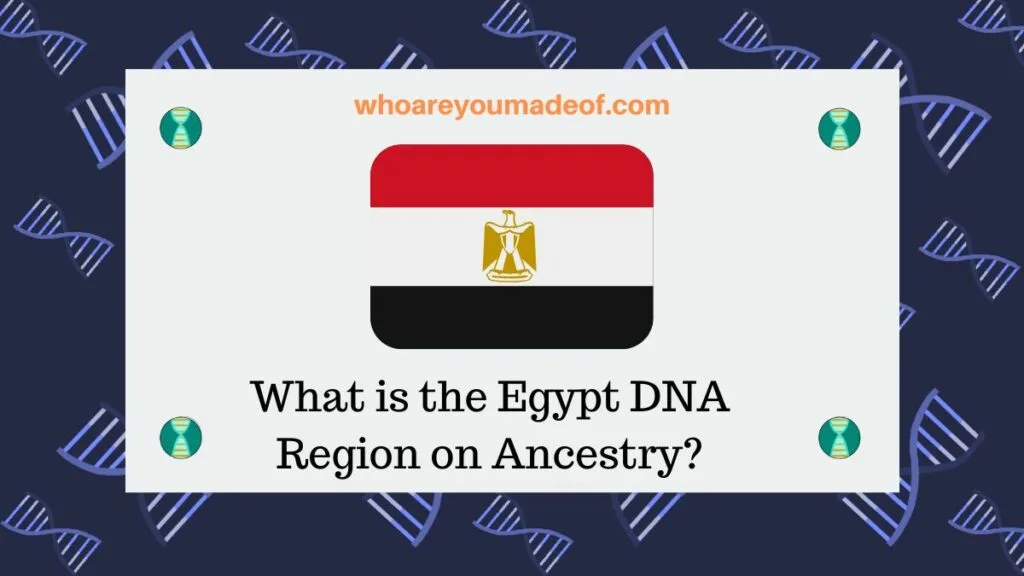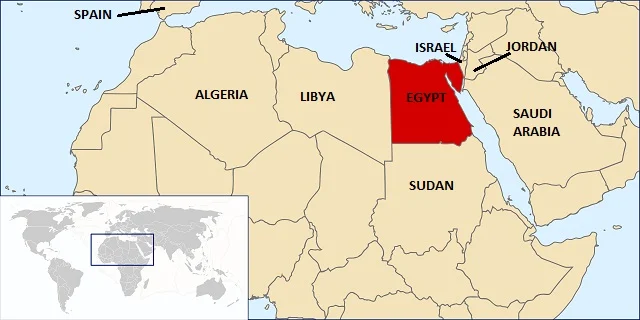Did you get the Egypt DNA region on your Ancestry results? In this post, learn more about this DNA region, and how to trace your Egyptian ancestors.

Egyptian immigrants to the United States and Canada have had an outsized contribution to their local economies and are typically very highly educated. In fact, these individuals are more than twice as likely as members of the average US citizen to have a Masters degree or higher level of educational attainment.
Most people are familiar with iconic symbols of Egypt's ancient culture, including its famous pyramids. Many Americans are less knowledgeable about the rich history of Egypt going back many thousands of years, and its continued global importance as the location of the intersection between Europe, Africa, and Asia.
Several hundred thousand people living in the United States and Canada have known Egyptian ancestry and identify as having Egyptian heritage, and many more have distant ancestors from this region. Individuals with DNA matching the Egypt DNA region are among excellent company.
Where is the Egypt DNA Ethnicity Region located?
The Egypt DNA ethnicity region is located in the northwest corner of Africa. The boundaries of the region are relatively confined to the actual political boundaries of the Arab Republic of Egypt, the official name of the country.

The map above shows the country of Egypt in red. You will note that the countries sharing an immediate border with Egypt are Sudan, Libya, and Israel.
It is possible to have ancestors from these neighboring countries, or other nearby geographic locations, and have DNA matching the Egypt region.
In which countries can you find DNA matching the Egypt region?
The primarily geographic for the Egypt DNA region on Ancestry is the country of Egypt itself. Egypt has Africa's third largest population, and is the continent's 12th largest country by size.
It is important to note that about 6% of Egypt's territory consists of the Sinai Peninsula, which is technically located in Asia. This peninsula has served as an important strategic territory for Egypt for thousands of years, and connects Africa to Asia.
Are there sub-regions for the Egypt DNA region?
While there are not currently sub-regions under the main Egypt DNA region, there are some sub-regions and DNA Communities under the Levant DNA region that correspond to parts of Egypt. For example, if you have a strong genetic connection to the Nile Delta area, including Cairo and parts north, you may have the Levant DNA region with the Nile Delta sub-region.
How did you get your Egypt DNA?
While many people might know how they inherited their DNA matching the Egypt region on Ancestry, others might not be sure. The most common way, of course, is from a recent ancestor who came directly from Egypt, which would also be the case for those DNA testers who live in Egypt.
Immigration directly from Egypt to the United States and Canada began in earnest in the 1970s. There were many factors that encouraged emigration from Egypt, but there was also a change to the Egyptian constitution in 1971 that relaxed rules for those who wanted to permanently leave the country.
Article 52 of the Constitution of the Arab Republic of Egypt 1971 codified the right of Egyptian citizens to permanent and temporary migration, which led many people to see better economic and political conditions in other countries.
If you are someone who does not have any recent Egyptian ancestry, then you might have inherited your DNA from one of the two following ways.
You may have inherited DNA from this region indirectly through ancestors who migrated away from Egypt
While many people from Egypt have come to live in North America, most outbound migrants from Egypt have not traditionally come to this continent. Saudi Arabia, Libya, United Arab Emirates, Jordan, Kuwait, Sudan, and Qatar are among the countries outside North America where the majority of the Egyptian diaspora lives.
During the last half of the 1900s, many left Egypt to live in one of the many countries mentioned in the list above. If you have a recent ancestor from any of those countries, you could consider that perhaps they may have had ancestry from Egypt.
Alternatively, a very small percentage of DNA matching this region could indicate very distant Egyptian ancestry. You can learn more about how to estimate how far back you might need to look in your family tree to find the source of your Egyptian ancestry further down in this article.
Your Egypt DNA region may be from an ancestor from a nearby region
If you have ancestors from a country that neighbors Egypt, or has a border near Egypt, such as is the case with Jordan, you could consider that one of your recent ancestors had more distant ancestry from the Egypt DNA region. Sudan, Libya, and Israel are countries that share a direct border with Egypt.
We often imagine that our distant ancestors were not able to move around as much as they have been able to do over the past 100-200 years, but this is likely to be a misconception. Over the past tens of thousands of years, humans on every continent have managed to make incredible journeys, despite great hardships.
How far back is your Egyptian ancestor?
We can use the percentage of DNA matching the Egypt DNA region to estimate how far back you would need to look in your family tree to find your Egyptian ancestors. In order to understand how to do this estimation, it's good to know the basics:
- Every person inherits 50% of each of their parent's DNA
- 50% of each parent's DNA is not passed down to the child
- The exact 50% of mom and dad's DNA that is passed down to their children is randomly selected through a process called recombination
Since we inherit 50% of each of our parent's DNA, we can use this information to make a few assumptions. For example, if someone has 5% of their DNA matching the Egypt DNA region, we could work on the basic assumption that one of their parents had about 10% matching the region.
This would mean that the DNA tester's grandparent had 20%, their great-grandparent may have had 40%, and their great-great grandparent had 80-100%. These are only estimations, however, since the DNA that is passed down is not always selected in exact increments.
It is important to consider that both parents may have passed down DNA matching the Egypt region. For example, if you show more than 50% of your DNA matching the Egypt region, then you should work on the assumption that both of your parents have ancestors from the Egypt DNA region.
Conclusion
I hope that this post has helped you learn how to understand your DNA matching the Egypt DNA region, whether it is recent or from the distant past. Additionally, I wish you the best of luck in learning about your ancestors from Egypt or its neighboring countries.
If you have any questions about something that you read in this article, or if you would like to add how your Ancestry results helped you learn about your Egyptian ancestors, please feel free to join in the discussion below.
Thanks for reading today!

Natalie
Saturday 1st of April 2023
I am trying to locate my biological father and my maternal ancestry report says Egypt. Can you give any help with this please?